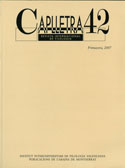La dislocació a la dreta en català i castellà: microvariació en la interfície sintaxi/pragmàtica
DOI:
https://doi.org/10.7203/caplletra.42.4826Keywords:
Right-dislocation, Microvariation, Syntax, Pragmatics Abstract
Abstract
This article investigates the use of right-dislocation in Catalan and Spanish. We have measured the productivity of right-dislocation in a corpus of an original Catalan text and its Spanish translation regarding four variables: category, grammatical function, discourse function, and distance with respect to the antecedent. The analysis shows that right-dislocation is a marginal phenomenon in Spanish, not only from a quantitative (10 occurrences vs. 232 occurrences in the Catalan text), but from a qualitative point of view: right-dislocation in Catalan affects all the categories, grammatical functions, discourse functions, and distances with respect to the antecedent, whereas in Spanish it is restricted to nominals (SD and DEM) and sentences (SC), to subject and object functions, mainly to a the (re)introduction of a topic in the discourse, and to extreme distances (1 and 4). So then, in order to fulfill the tasks covered by right-dislocation in Catalan, Spanish must resort to other mechanisms —
the placement of the dislocate in situ, its omission, or left-dislocation—, which suggests that the difference between these languages has to do with the different discourse management of the same collection of syntactic resources.
 Downloads
Downloads
Downloads
Published
How to Cite
-
Abstract550
-
PDF (Català)232
Issue
Section
License
Authors submitting work to Caplletra for publication must be the legitimate holder of the usage rights. Legitimacy for the purposes of publishing the work must also include images, tables, diagrams and any other materials that may complement the text, whether they are the author of such material or not.
Copyright: on publishing their work in the journal, the author grants Caplletra. Revista Internacional de Filologia usage rights (reproduction, distribution and public communication) for both the paper printed version and for the electronic version.
All work published in Caplletra is covered by the Creative Commons license type Attribution-NonCommercial-NoDerivatives 4.0 (CC BY-NC-ND 4.0).
RESPONSABILITY
Caplletra. Revista Internacional de Filologia does not necessarily identify with the points of view expressed in the papers it publishes.
Caplletra. Revista Internacional de Filologia accepts no responsibility whatsoever for any eventual infringement of intellectual property rights on the part of authors.






